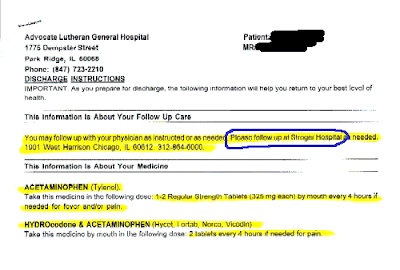
My discharge paperwork from Lutheran General, referring me to Stroger Hospital.
The Chicago Tribune delved into one reason the emergency room at Stroger Hospital is so crowded:
"Indigent and under-insured patients are turning to Cook County's Stroger Hospital after not getting fully treated at non-profit hospitals, swamping the cash-strapped public facility while fueling the county's sky-high sales tax, a Tribune investigation found.The Trib's account mirrors my experience at Lutheran General, which is part of the nonprofit Advocate Health Care system.
"Some of these patients arrive at Stroger's emergency room bearing discharge slips, prescriptions, even Yahoo and Google maps from non-profit hospitals, according to documents obtained by the Tribune....
"Non-profit hospitals, meanwhile, reap millions of dollars in property and sales tax breaks from the county, based largely on the promise that they'll help the uninsured....
"'This is basically legalized patient dumping,' said Dr. Jesse Pines, an assistant professor of emergency medicine at the University of Pennsylvania School of Medicine...."
The story underscores an important point about the Emergency Medical Treatment and Active Labor Act, which requires most hospitals to treat patients at emergency rooms regardless of ability to pay: All the hospital must to do is diagnose and stabilize you. They don't actually have to treat what's wrong with you.
For most uninsured patients, emergency-room treatment is little more than basic first aid, not health care.
Chicago Health Matters notes that 75 percent of Illinois hospitals report higher numbers of uninsured patients. Stroger is barely able to cope as it is. Patients already wait months for followup care. The county's nonprofits, despite the tax breaks they get, aren't taking on their fair share.
Nonprofit hospitals don't pay taxes. They don't pay stockholders. They receive tax-free grants and donations (and the donors get tax breaks, too). So, as The Wall Street Journal reported last year, they rake in huge revenues.
For example, in its 2007 annual report, Advocate recorded $3.5 billion in gross revenues. The hospital claims that it spent about 7.6 percent of that on "charity care and other uncompensated costs" but that number includes what it calls the "unreimbursed costs of Medicare, Medicaid and other government-sponsored programs." So it's counting as "charity" the difference between what the U.S. government has determined is fair payment and whatever arbitrary rates the hospital charges patients paying out of pocket. And nearly half of the figure is bad debt, grudging "charity" at best.
Advocate's net revenues in excess of expenses for 2007 were $260 million. That's after the "charity" care and after they pay out whopping salaries like CEO James Skogsbergh's — $2.2 million a year plus another $1.35 million in benefits, according to 2007 IRS filings. (Other folks on the payroll do pretty well, too. Bruce Campbell, president of Lutheran General, takes home $1.5 million in wages and benefits. Surgeon Leonard Kranzler makes some $1.6 million from Advocate, plus whatever he nets from his private practice.)
For the tax breaks they get, shouldn't nonprofit hospitals take on a much bigger share of caring for the poor and the uninsured?



This is a great summary of what is going on in our hospitals. Nonprofits should take on their share. The system is strained to the max.
ReplyDeletePatients are lost to follow up or get no followup and end up back in ER as primary care provider. The most hospitals can do is help patients connect instead of referring to another hospital.